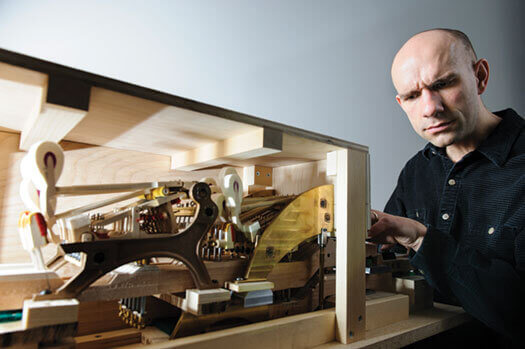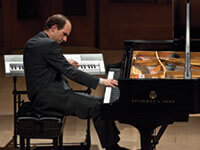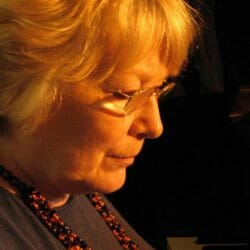The Frankenpianist
Christopher Taylor lives a double life. His public identity is that of a concert pianist and keyboard guru. But in private, he uses his creative energies for invention.

Christopher Taylor works on a model for his invention, the double-manual keyboard instrument. The rows of hammers create a geometric problem, but they don’t actually make music. Their sole purpose is to give the instrument the feel of a traditional piano. Photo: Jeff Miller
Christopher Taylor’s office doesn’t look like the lair of a mad genius.
It lacks the medieval gloom of Victor Frankenstein’s castle or the pharmaceutical range of Henry Jekyll’s London atelier or the isolation of Dr. Moreau’s island. But a lair it is, nevertheless. Taylor’s cramped space on the fourth floor of the Mosse Humanities Building is a laboratory for the relentless pursuit of the unique. Within it, he creates and curates a collection of things that can be found nowhere else in the world.
This is not his day job. Taylor is a professor in the School of Music, and one of the reasons his office is cramped is that he keeps two grand pianos in it — the second a little more grand than the first, but we’ll get to that later.
His status as a genius is not in doubt. As a pianist, he thrills crowds on the classical music circuit with a playing style so intense that the New York Times compared it to demonic possession. On the UW’s music faculty, he jokes that he’s become something of the “guru on the mountain,” though it’s not far from the truth.
“He has different insights than you would get from anyone else,” says Jonathan Thornton DMAx’14, one of Taylor’s graduate students. “He helps me get to the root of the music — figuring out how to make the piano make the sounds I want, and interpreting the score to put moods together.”
But Taylor leads a double life: on the one side a devotion to music, and on the other a fascination with math, computer science, and technology.
“It’s always been important to me to maintain a diversity of mental activities,” he says. “I don’t want to just be chained to the piano all day long.”
The two lives unite in his current obsession — the creation of a new musical instrument. On its patent application, it goes by the prosaic name of double-manual keyboard instrument; some of Taylor’s students use the more poetic title Frankenpiano. To Taylor himself, it’s just my invention.
“It’s a monster of a project,” he says. “I’ve been at it off and on for three or four years now, but the last couple of years, things have moved into a higher gear.”
If he can get it to work, the invention could offer new possibilities for piano players. It could spark a musical revolution in the way that the invention of the piano did three hundred years ago.
Jekyll and Hyde
Taylor grew up in Boulder, Colorado, in what was a musical home, though not a home full of musicians. His father was on the physics faculty at Colorado University, and his mother taught high school English. But the family owned a piano, and Taylor began taking lessons as a grade-schooler.
“It was initially just with a neighbor down the street,” he says, “but it soon became pretty clear that I needed to get a really serious teacher.”
Before age ten, he was playing Beethoven. By high school, he was writing his own music. “I used to do a little composing,” he says. “But somehow life got busy.”
And it was the business of life that made him reluctant to pursue music as a career.
“I was a pretty determined fence-sitter,” he says. “I knew that music was my number-one allegiance, but I also knew it was a highly impractical field to get involved with. And I didn’t want to restrict myself — I wanted to keep my options open, both for pragmatic reasons and for more intellectual reasons.”
Taylor’s other great skill was mathematics, and when he went to college, he majored in math at Harvard, but also studied piano under Russell Sherman at the New England Conservatory of Music. There he began to catch the attention of the classical music community. In 1990, between his sophomore and junior years, he won the University of Maryland’s William Kapell International Piano Competition. Later that year, he made his debut in a recital at Alice Tully Hall in New York’s Lincoln Center. And in 1993, he took the bronze medal at the quadrennial Van Cliburn International Competition.
“The very concept of a number-one winner works better in a footrace than in music,” he says. “But in retrospect, I think [third place] was a very nice result for me. The gold medal can be kind of a curse, in that you get thrown into the deep end. All of a sudden you’ve got eighty concerts a year, which is a recipe for burning out.”
Among the pieces Taylor played at the Cliburn was the Goldberg Variations, which composer Johann Sebastian Bach had written for a double-keyboard harpsichord. Taylor mastered it on a single-keyboard piano, and it’s since become something of a signature piece for him.
“No sane pianist could possibly resist the allure of that piece,” he says. “It’s the Mount Everest of the literature. It’s intense and difficult. Like so much of Bach, it combines the best of everything.”
After the Cliburn, Taylor spent several years as a concert pianist, playing “not eighty gigs a year, but probably thirty,” he says. He married and moved to Ann Arbor, Michigan, where his wife was working on her doctorate in music. But he spent weeks on the road, doing shows across the United States and in Europe. He developed a reputation for physically intense performances that would leave him, his piano, and even the floor covered in sweat. On occasion, a mop was needed between numbers.
“It’s a highly physical activity,” Taylor says of playing a concert. “And I’m an active person. It wasn’t an explicit part of my instruction; it’s part of my personality.”
The itinerant life of a concert musician is grueling, but he enjoyed it. Still, he felt that he had more to offer. Eventually he decided that he wanted to teach. When the University of Wisconsin invited him to apply for a spot on the faculty, Taylor made the move to Madison.
“I like an existence that gives me a little more time to breathe and to contemplate,” he says.
Frankenapps
Taylor also likes a life that gives him the opportunity to explore his other side, his mathematical side.
“It’s an acquired taste, I suppose,” he says, “but mathematics was always a good field for me. It’s extremely abstract, and I like things that are a little removed from the real world.”
Taylor’s interest in math extends beyond pure abstraction, however, and he’s experienced an increasing curiosity about computer programming. Discovering that he didn’t care for the calendar program on his Android phone, he designed his own. Wanting a metronome — the inverted pendulum that musicians use to keep time while they practice — that would adjust to changes in tempo, he wrote another app for his phone, a metronome into which he can enter all the variations that a piece of music goes through, transitioning at all the right points.
“It keeps me mathematically honest about [the music] on the page,” he says.
Indulging a childhood fascination with geography, he raided the U.S. Geological Survey website and downloaded all 65,000 of its topographic maps for the country.
“I put them all on a half a terabyte drive,” he says. “They’re TIF files, so you can view them with Microsoft Picture, or whatever. But I wanted something specifically geared toward maps — something speedy and efficient. I wanted to be able to move from one map to its neighbors, and I wanted to use some 3-D graphics programming to create three-dimensional versions. It sort of grew into a topographical database — one giant, virtual topo. And I added the ability to fly over from some particular angle and elevation. I guess it’s my answer to Google Maps.”
The programs exist only on his phone and his computer, their uniqueness marking both his idiosyncrasy and the mercurial nature of his interests.
“I don’t have that much entrepreneurial spirit,” he says, “so I haven’t made a fortune posting them online. They’re pretty much for my own entertainment.”
But when it comes to the invention — the Frankenpiano, the double-manual keyboard instrument — Taylor has an eye toward the wider world. The Wisconsin Alumni Research Foundation has helped him patent it, and with aid from the Morgridge Institute for Research, he’s building a physical model. Completing it will represent not only a new development in music; it will also continue the story of a unique artifact in the UW’s possession and one of the curiosities of twentieth-century music.

Taylor manages two keyboards at once during a California concert. Known for his energetic playing style, Taylor may leave his instruments covered in perspiration. “It’s a highly physical activity,” he says. “And I’m an active person.” DavidBaZemore.com
Frankenpiano 1
Here’s where that second piano comes in, the one that clutters the back of Taylor’s office. Its posterior stretches longer than a standard grand’s, but that’s not what makes it unique. The uniqueness is on the front side. It’s the only Steinway grand in the world with two keyboards, one above the other.
Built in Hamburg, Germany, in 1929, the instrument was designed for Hungarian composer Emánuel Moór. (If anyone suggested Frankenpiano to him, he ignored the suggestion. He called it an Emánuel Moór Pianoforte.) Moór was an inveterate tinker and a fan of complicated music, so he conceived of a piano that would let players reach greater spans than the human hand is capable of. His instrument has two keyboards and 164 keys. The lower board has the standard piano’s 88, and the upper board has 76, offset one octave. Thus players can create a chord that is eight notes broader than they could on a normal piano. To keep the size of the piano from growing ridiculously large, the keys on each board connect to the same hammer and strike the same string. Depress middle C on the lower board, and on the upper board, a key eight to the left sinks with it.
Moór had his detractors — many pianists found the instrument impossible to play. But he also had his fans, including members of Germany’s wealthy von Siemens family, who commissioned the double-keyboard Steinway for his concert hall in Berlin, where it resided until 1945.
The double-keyboard piano suffered damage during World War II, and afterward it was shipped to the Steinway factory in New York for repairs. (The company’s Hamburg factory had been bombed, too, evidently destroying the instrument’s original designs.) Once in the United States, the instrument was discovered by Danish pianist Gunnar Johansen, whom the UW had made an artist-in-residence in 1939: the first such post for a musician at any American university. Johansen had been a fan of Moór, and he coveted the piano. He convinced university donors to buy it for him, which they did — on the condition that ownership would revert to the UW when Johansen died. He passed away in 1991, but by that time, no one was interested in the Moór piano, and it went into storage for fourteen years until Taylor rediscovered it.
In 2005, Taylor began working with the Moór piano, learning the possibilities that it offered. It has resided with him ever since, an object of inspiration, and a perfect medium for playing the Goldberg Variations. Impressed with the ingenious fit of its keys and hammers, he began poking around its insides to explore the instrument’s strengths and weaknesses.
“It’s a little hard to control,” Taylor says. “The upper keyboard, in particular, is very heavy, very difficult to play reliably at the soft dynamic level. So I started thinking about inventing. Could I make another of these instruments, one that could overcome these problems and take advantage of modern technology?”
Frankenpiano 2
And so Taylor began to build his monster — which, admittedly, doesn’t appear monstrous. The invention’s central console looks a bit like a wide roll-top desk. It stands on twenty-three-inch legs, which support a box twelve inches tall, fifty-four wide, and thirty-two deep.
Taylor’s initial drawings were functional, but prosaic, and so he collaborated with his very own Igor, Madison cabinetmaker Kevin Earley, to refine the plan. Earley added flair to the legs and corners and constructed the console’s case out of walnut.
“It has a natural depth to the grain,” Earley says. “You don’t get that with just a colored finish.”
But that’s just the container for the instrument. The real complexity is on the inside, where Taylor had to use more math than music.
The internal structure of even a normal piano is something of a geometry problem. The player may interact with eighty-eight keys, spread out neatly in a row. But each of those keys is just one end of a lever: push down, and it depresses a hammer that must strike one — and only one — string, and not any of the other eighty-seven strings.
Taylor’s invention won’t have strings, but it will face geometry that’s twice as complex. To make the instrument play like a piano, each of the 176 keys — two full keyboards, one above the other — is a lever connected to a hammer, all of which must fit in the console’s fifteen cubic feet.
“Shapes are the critical thing,” Taylor says. “Once you get beyond the visible end of the keys, all this hidden stuff, whether it’s on a weird piano like mine or on a perfectly normal piano, there are complicated angles that take place when you get back into the tail sections. They have to follow a particular course, because they have to angle their way around and avoid interfering with each other.”
The process of invention has forced Taylor to learn new skills, both in design and in mechanics.
“I’ve had a lot of assistance from the Wisconsin Institutes for Discovery, down in their fabrication lab,” he says. “People there have been very friendly and showed me the ropes about how I might actually design [the internal workings]. I’ve learned to use 3-D software and [computer-assisted design] software. And then I’ve also learned to operate some of their computer-controlled equipment — the mills and the routers and the lathes and so forth.”
Once past the hammers, the similarities between Taylor’s invention and a normal piano end. Instead of striking strings, Taylor’s keys will trigger electronic transmitters.
“The console’s not going to make any sound at all,” he says. “The hammers aren’t there to make actual music. They’re just there to make it feel normal to the pianist.”
The transmitters will relay instructions to player pianos — one linked to the lower keyboard at one end of the stage, and one to the upper keyboard at the other end of the stage.
“The goal is for it to feel totally like a normal piano,” he says, “and for it to produce a piano sound. But it will enable the pianist to produce really big chords.”
The size of those chords could end up being as big as the player’s ambition, because the relationship between the two keyboards can be set anywhere he or she likes. Because the keys are not physically linked to anything that makes sound, the lower and upper keyboards can be calibrated to suit the composition. Want a standard piano arrangement? Set the lower keyboard to the traditional arrangement. Want an extra octave of reach? Set middle C on the upper keyboard eight keys left or right. Want two extra octaves? Set it sixteen keys farther away. Or thirty-two.
“The chords,” Taylor says, “will be superhuman.”
It’s Alive? Not Yet.
In December, Taylor and Earley met to put Taylor’s hammers and keys into Earley’s box. But a completed console is hardly a finished instrument. Taylor must continue with the work of programming and designing to marry the keys to the sound-making elements.
“I’m probably another year away from completion,” he says.
And while he works on his invention, he continues to teach and to play, with concerts in Madison (a recent favorite venue is the Wisconsin Institutes for Discovery) and Los Angeles and Sarajevo. The diversity of mental activities continues to grow — and the invention may turn his interests back to the composing he gave up after high school.
“That’s something the invention will sort of force me back to,” he says. “If not composing, at least arranging.”
If so, he may note that no one has yet written the definitive symphonic version of Mary Shelley’s novel.
Now senior editor of On Wisconsin, John Allen took piano lessons long enough to learn how to play “Chopsticks” with chopsticks.
Published in the Spring 2014 issue



Comments
Tana May 15, 2014
Impressive, I hope we get to hear a song or two after it is completed.
Carol A S Beckius June 12, 2014
This was a fascinating piece.